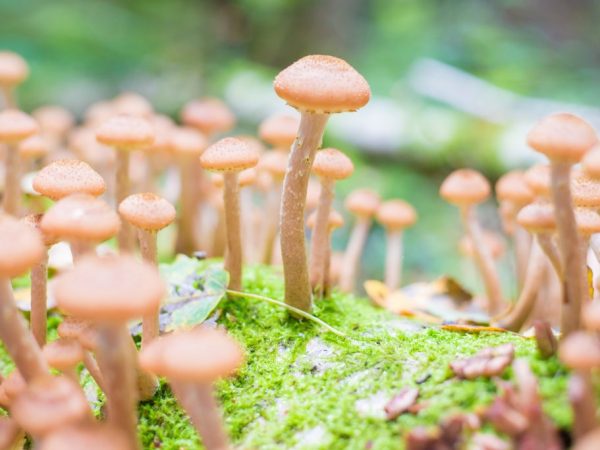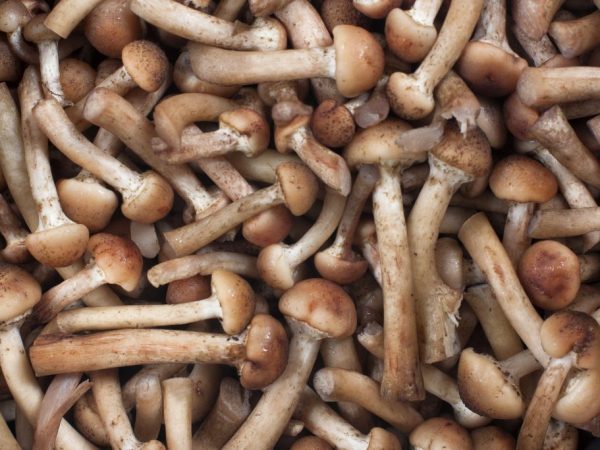Collection of spring honey agarics
Spring mushrooms have many other names: wood-loving kollibia, oak-loving kollibia, tree-loving money. From the Latin language, the name of this mushroom is translated as "bracelet", and all because honey mushrooms grow on a hemp in the form of an ornament - a bracelet.

Collection of spring honey agarics
general information
Spring honey is an early mushroom that grows in spring. They appear in May and grow until October. The largest number is in June and July. The external description includes the following features:
- cap: small (about 7-8 cm in diameter), smooth, creamy, brownish-yellow, brown or red; for young fungi, a convex cap is characteristic, which then becomes prostrate with a lowered edge;
- hymenophore: white, cream colored plates, frequent, adherent;
- stem: smooth, thin, about 5 cm in length, from below - hard, thick and fibrous, slightly lighter than the cap of the mushroom;
- whitish, light, tender pulp with a pleasant mushroom smell.
Growing places
Spring mushroom is a fairly common mushroom. It grows preferably in dead woods, mixed and coniferous forests. The northern hemisphere and the subtropical zone are densely populated with these mushrooms. Spring honey does not grow only in regions with the presence of permafrost.
Honey mushrooms quickly capture large areas for their territory. You can find them not only in the forest, but also near bushes, in meadows and forest edges. Most often, large groups are found near weakened trees in the forest, on stumps and logs. They appear in early May, and grow until autumn.
Similar species
If we take the description for comparison, then we can clearly say that the oak-loving colibia has several similar species of honey agarics. For example, meadow mushrooms. A distinctive feature for these two species is the frequent plates of the colibia hymenophore.
There are many closely related species, which are visually indistinguishable (or very difficult) from oak-loving colibia. In comparison with the chestnut colibia, it should be noted that the spring honey agaric has a thickened cylindrical leg.
Useful properties and contraindications
Honey mushrooms are one of the most common mushrooms. He is a low-calorie product. They contain such useful substances:
- vitamins of group B, C, PP and E;
- trace elements (phosphorus, potassium, zinc, iron);
- cellulose;
- amino acids;
- proteins;
- natural sugars.
This mushroom is edible, but does not have a high taste. They can be simply fried or pickled with other mushrooms.

Mushrooms should not be given to children under 12 years old.
Honey mushrooms can be easily confused with inedible mushrooms, so you need to collect them with extreme caution. Inedible species have a downward leg. They have a specific sour unpleasant odor. Real mushroom pickers can easily distinguish edible from poisonous species. Their main difference from inedible species is the "skirt" (the remains of a private veil that protected the hymenophore) under the mushroom cap.
From the contraindications, remember that you cannot feed these mushrooms to children under 12 years old.And keep in mind that vinegar, used in large quantities when pickling, is dangerous for people with diseases of the gastrointestinal tract, such as ulcers and gastritis.
Cooking applications
For culinary dishes, it is better to use mushroom caps, because their legs are hard, especially from the bottom. Wash the mushrooms thoroughly before cooking. It takes a long time to cook wood-loving colibia, about an hour, although it all depends on the size of the mushrooms.
Heat treatment is a mandatory step in the preparation of any mushrooms. Spring mushrooms are prepared in different ways: they are stewed, fried, pickled. They are perfect for a vegetable side dish or as an addition to pork, lamb, poultry. Honey mushrooms with herbs and sour cream are a great combination and they perfectly diversify the table.
In medicine
Honey mushrooms have medicinal properties. Kollibia woody is used dry and fresh. It has a positive effect on the human body. Frequent consumption of mushrooms will help strengthen the immune system, improve the functioning of the cardiovascular system. They improve hematopoiesis (the formation of blood cells) and are indispensable for a vegetarian menu, because due to their composition they will help to partially replace fish.
Honey mushroom has a positive effect on the functioning of the gastrointestinal tract, it is used to treat liver diseases. Demonstrates antioxidant, antiviral, anti-inflammatory effects.
Growing at home
These mushrooms are great for growing at home. One of the most popular methods is stump breeding. On the stump of an apple, pear or birch tree, you need to plant small pieces of honey agarics and cover them with moss. You can collect the first mushrooms in a year.
Irina Selyutina (Biologist):
When choosing a growing base (stumps), it is important to ensure that it is not affected by the mycelium of parasitic fungi (tinder fungi). To create the necessary moisture, the stumps are soaked for 2-3 days with full immersion in water or with periodic (throughout the day) watering. The following methods are used to populate stumps:
- Purchased mycelium.
- Part of the mycelium of honey agarics from the forest.
- Seed material from caps.
To prevent the developing mycelium from "moving" to the healthy trees of your site, a ditch is dug around the stumps at a distance of 2 m, at least 30 cm deep and 10-15 cm wide.
Stumps infected with mycelium are covered (instilled) for the winter and covered from above to protect the ends from melt water.
There is another way for the townspeople - growing in glass jars. In a special mixture consisting of boiled bran, wood sawdust, starch, flour, plant small pieces of mushrooms. This method is striking in its speed. Wait for the first harvest in a month.
Conclusion
Honey mushrooms are low-calorie, tasty mushrooms that will perfectly fit into your diet. They have a lot of useful vitamins and minerals, and for real mushroom pickers, the collection process will be a real pleasure.


